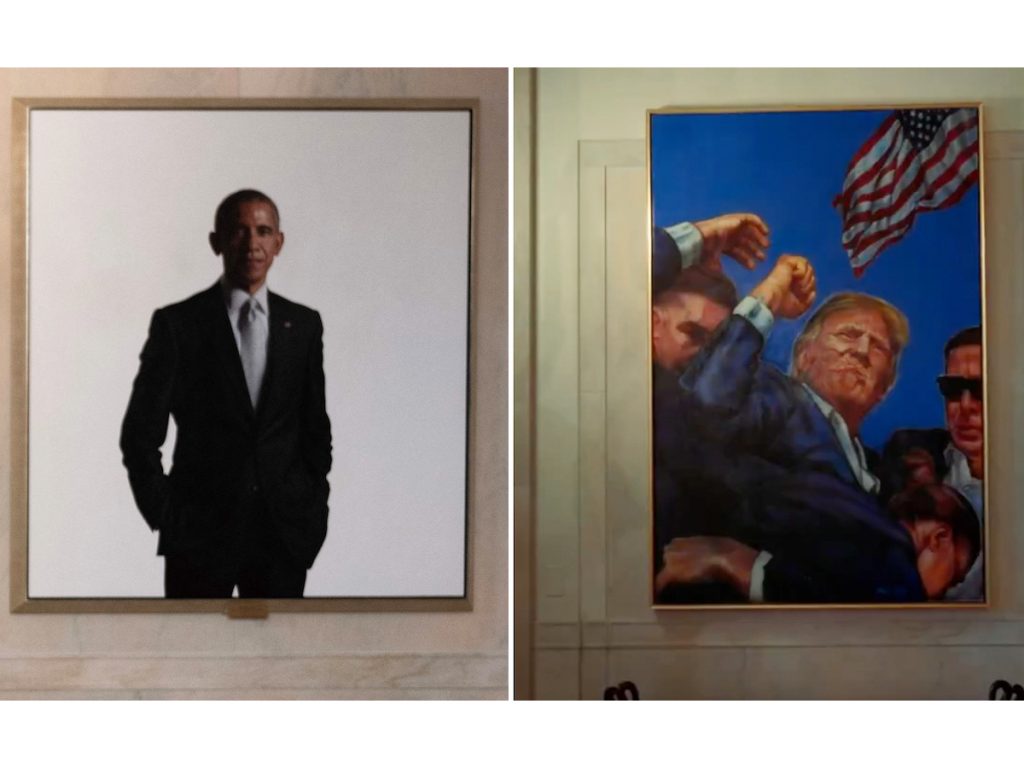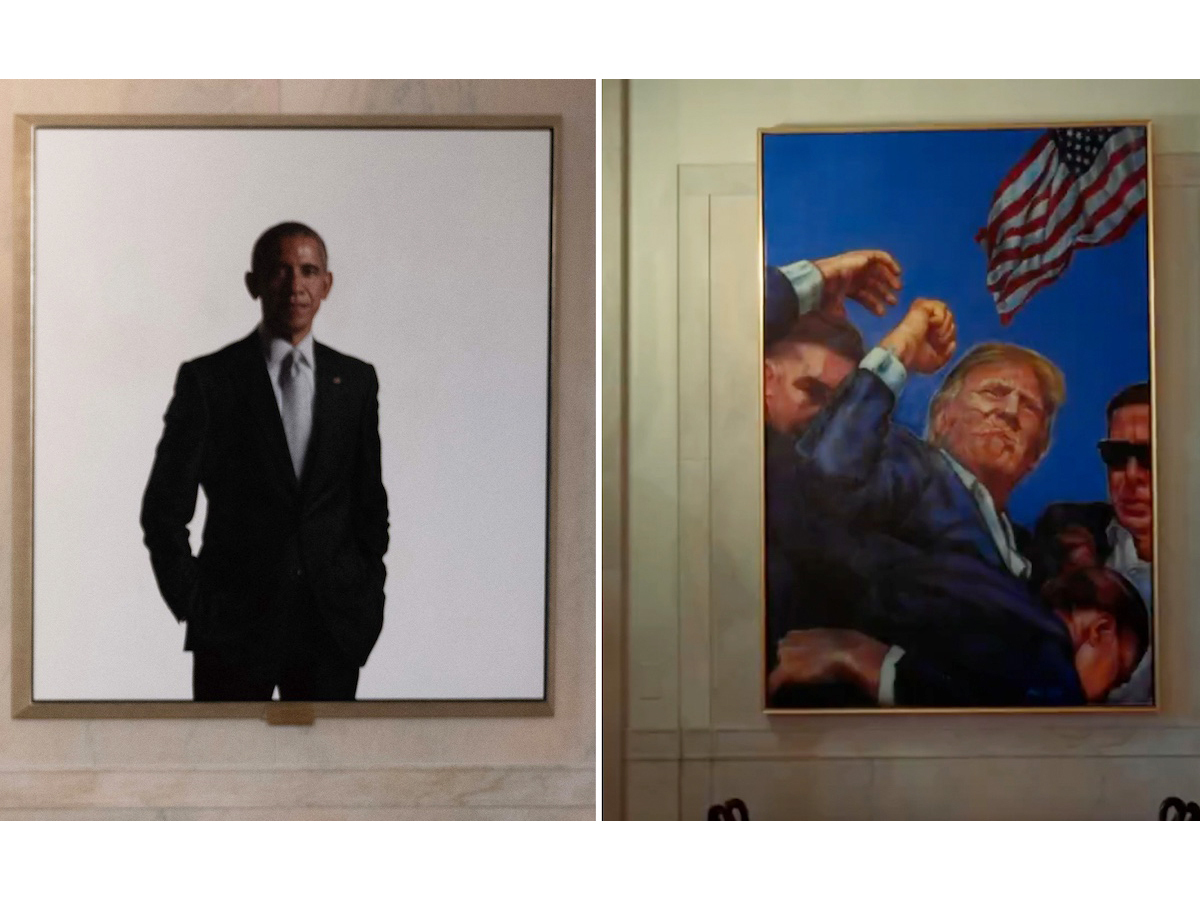
White House Replaces Official Obama Portrait with New Painting Depicting Trump with Raised Fist

Title: Trump’s New White House Portrait Sparks Uproar After Replacing Obama’s
A recently released video from the White House has stirred widespread controversy after it revealed what appears to be a new painting of former President Donald J. Trump replacing the official portrait of President Barack Obama in the Grand Foyer. The three-second video clip, posted on April 11, 2025, via the White House’s official X (formerly Twitter) account, features visitors walking past a large, vivid painting of Trump during the moments following the failed assassination attempt at his July 2024 campaign rally in Butler, Pennsylvania.
This unexpected art placement is raising sharp questions about presidential portrait traditions, propaganda, and the politicization of historical space within the White House.
The New Trump Portrait: A Symbol or a Spectacle?
The Trump painting in question is a vivid, stylized depiction drawn from viral photos taken by Doug Mills of The New York Times and Evan Vucci of the Associated Press. It showcases Trump with blood visible on his face, raising a clenched fist under the American flag while being shielded by Secret Service agents—a moment he and supporters quickly embraced as an image of resilience and martyrdom.
The theatrical nature of the image—a rally, an act of violence, a triumphant fist—has not gone unnoticed. Critics argue it strays far from the dignified, reflective nature of presidential portraits typically curated by the White House Historical Association (WHHA).
While the identity of the artist remains unknown, speculation swirls regarding its origins, considering the Kremlin’s recent confirmation that President Vladimir Putin gifted Trump a portrait. Whether this new artwork is the same piece remains unverified.
What Happened to the Obama Portrait?
Prior to the recent change, a minimalist and contemplative portrait of Barack Obama by Robert McCurdy adorned the same prominent wall. Commissioned in 2022 by the WHHA and unveiled with much fanfare, McCurdy’s image was celebrated for showing Obama in a matter-of-fact light, free of symbolism or visual spectacle—strikingly different from Trump’s recent installment.
Trump’s spokesperson claimed the Obama portrait has not been removed entirely but “relocated” to the entrance hall of the White House state floor. Yet, the symbolic act of replacing Obama’s portrait in such a high-traffic, central space stirs a deeper conversation about influence, erasure, and legacy-making.
Portraits as Political Messaging
Traditionally, the WHHA manages the creation and installation of presidential portraits, producing two versions: one acquired by the Smithsonian National Portrait Gallery and one for permanent display in the White House, typically unveiled after the president leaves office. These portraits usually feature posed settings that emphasize statesmanship over spectacle.
Trump’s new painting diverges significantly from these norms in both form and context. It’s not only unsolicited (at least by WHHA standards) but echoes a recurring pattern of political messaging through art—what some call “visual propaganda.” In fact, last month, Trump protested and effectively succeeded in the removal of a Colorado State Capitol painting portraying him unfavorably, suggesting pressures to control his public image extend across institutions, not just the White House.
Public Reaction and Cultural Ramifications
The White House video greeted viewers with no explanation, allowing the internet to fill in the blanks. Public responses have ranged from outraged to celebratory. Art historians and cultural theorists highlight how portraiture in official spaces contributes to the shaping of public memory. By replacing a widely celebrated Black president’s image with an aggressive, stylized self-glorification of his successor, critics argue the move is symbolic of more than just personal preference—it’s a rewriting of history.
Photographers Mills and Vucci have expressed unease about their images being co-opted without permission, especially as they become instrumental in shaping a highly polarizing narrative. Their publications, The New York Times and Associated Press, have not yet issued formal statements regarding use of their materials for the painting.
Final Thoughts
This incident is a reminder of the power of art in public spaces and political storytelling. The replacement of Obama’s reflective portrait with a dramatic depiction of Trump mid-crisis signifies more than aesthetic preference—it’s a calculated statement aligned with Trump’s self-image as a defiant hero under attack.
As America continues to grapple with questions of truth, history, and political representation, the space above the White House’s Grand Foyer offers a window—both literal and symbolic—into the current administration’s priorities, and perhaps, its desire to visually dominate the narrative.
Whether this particular portrait will remain in place or trigger further changes remains to be seen. One thing is certain: presidential portraiture, once a subtle form of statecraft, is now a battleground for legacy and ideology.